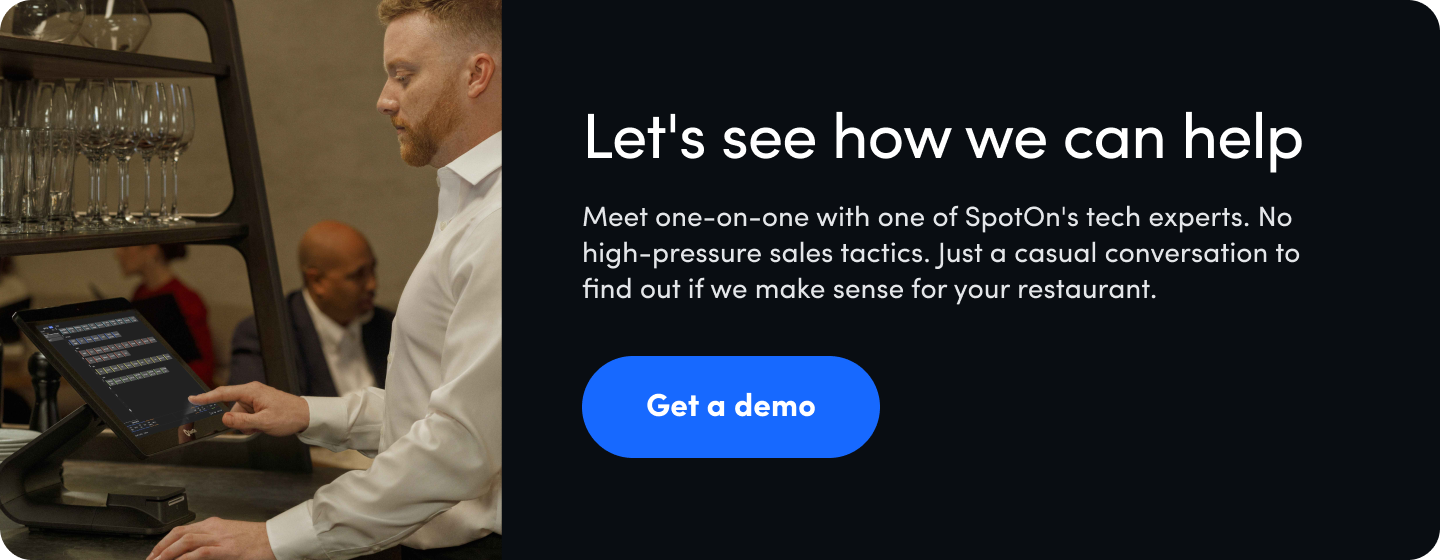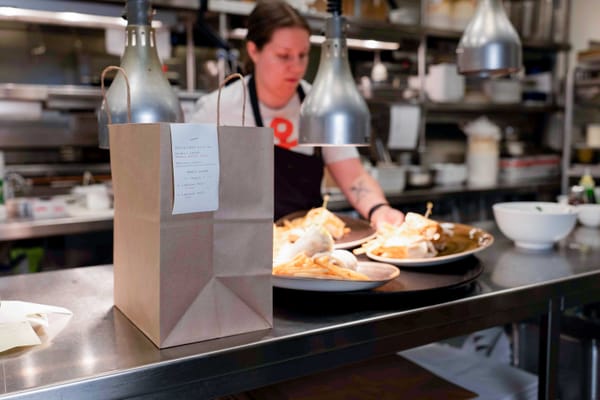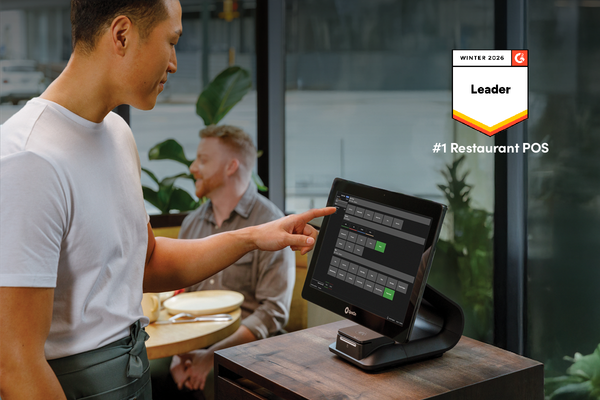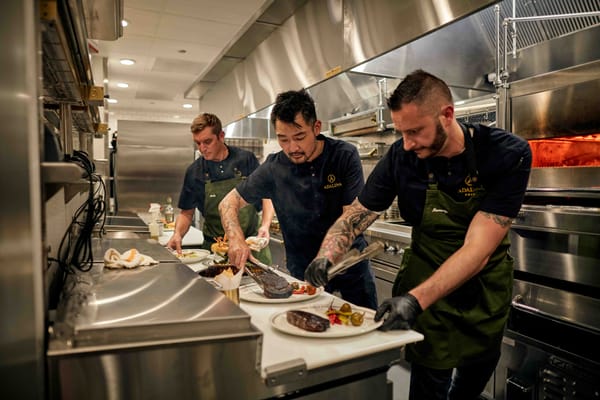In this article:
- What is restaurant SEO and why it matters
- How local SEO works for restaurants
- Optimize your Google Business Profile
- Use the right keywords on your website
- Create SEO-friendly website content
- Get listed in online directories
- Encourage and respond to online reviews
- Track your results without getting overwhelmed
- Frequently asked questions about restaurant SEO
There are two ways operators can attract new customers to their restaurant:
- Paid advertising
- Organic marketing
If you’re like most restaurant owners, you don’t have extra cash lying around to throw at ads every week.
Running Facebook and Google campaigns might get your name out there, but the moment you stop dumping money into it, the visibility dries up.
It’s a short-term fix—at best.
That’s why organic marketing, more specifically restaurant SEO, is a far better long-term strategy and solution.
It helps your restaurant show up in front of hundreds—if not thousands—of potential customers searching online for somewhere to eat, and it doesn’t cost you a thing to get there.
The only problem is that figuring out how SEO works can feel overwhelming and tedious.
The steps aren’t obvious, the advice is often filled with technical jargon, and it’s easy to waste time on things that won’t actually help your restaurant rank higher on Google.
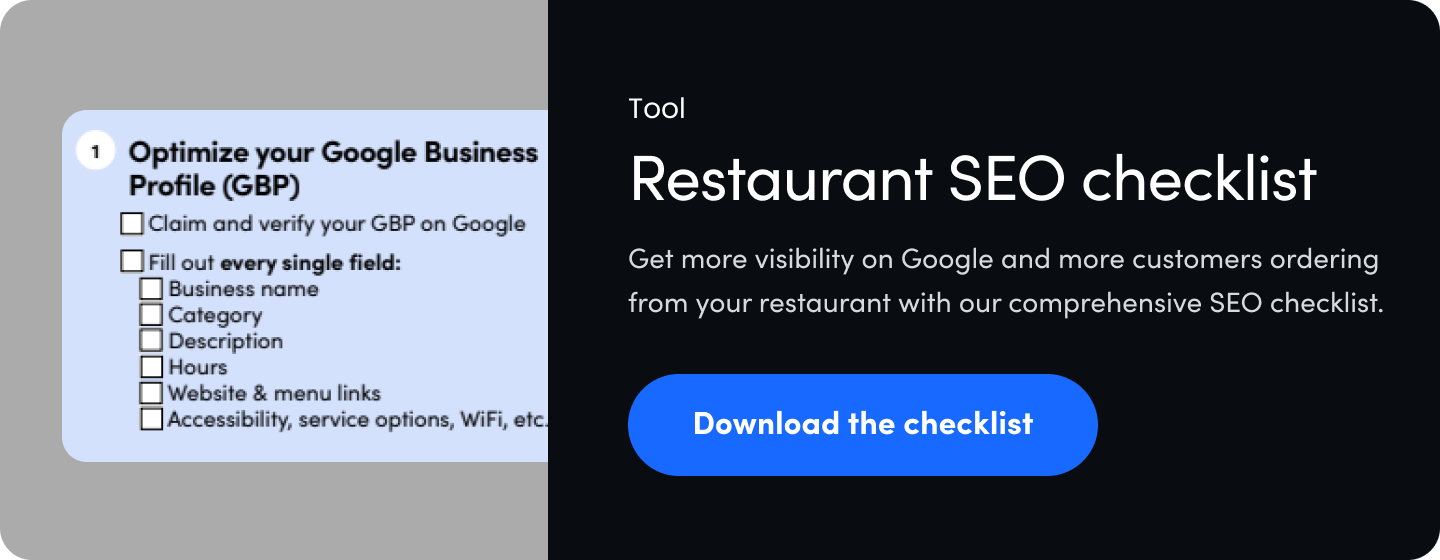
In this guide, I’m going to show you precisely what to do to improve your restaurant’s SEO and help you reach more customers.
After reading this article, you’ll know how to:
- Show up in local search results and on Google Maps
- Optimize your Google Business Profile to get better visibility
- Use simple SEO tactics to bring in new customers consistently
Let’s start with the basics—what SEO is and why it matters for restaurants like yours.
What is restaurant SEO and why it matters
Restaurant SEO is short for Search Engine Optimization—a set of tactics and techniques you can use to help your restaurant show up higher in search results when people look for food online.
For the sake of this article, we’ll focus solely on SEO tactics related to Google. A little over 90% of all online searches happen there, which means trying to optimize for Bing or DuckDuckGo just isn’t worth the time.
SEO isn’t about “gaming the system” (you can’t trick Google, FYI) or hoping to get lucky with a viral post.
It’s about refining your restaurant’s website, business profiles, and online content so they’re clear, relevant, and aligned with what potential customers are already searching for.
Done right, SEO helps your restaurant earn more visibility on Google Search, Google Maps, and even the other search engines we mentioned above—without paying for a single ad.
Here’s why that matters:
Most people use their phones to find somewhere to eat. They aren’t scrolling through social media or clicking on banner ads—they’re typing what they want into Google Search and picking from the top few options.
If your restaurant isn’t showing up in those search results, you’re essentially invisible to people, even if they’re only a couple of blocks away.
That’s what makes restaurant SEO so powerful: it puts your business in front of potential customers at the exact moment they’re looking for what you offer.
How local SEO works for restaurants
Local SEO is the process of optimizing your online presence so your restaurant shows up in local search results—meaning the people searching for things on Google in and around your area.
For example, someone looking for something to eat might Google, “best sushi near me” or “Mexican food in Pasadena.”
When your local SEO is dialed in, it means your restaurant appears in those search results.
Three main factors influence local search visibility:
- Proximity: How close the searcher is to your restaurant
- Relevance: How closely your restaurant matches what they’re searching for
- Prominence: How well-known or well-reviewed your restaurant appears online
These signals help Google Maps and other platforms decide which restaurants to feature in a local search result. When you get them right, your restaurant becomes eligible to appear in one of the most valuable spots on Google Search: the local pack.
The local pack is the box of three map-based results that appear at the top of Google Search when someone searches nearby.
For example, these are the search results for “Mexican food in Pasadena.”
Securing one of the top three positions is a massive boost in visibility and can drive significant foot traffic and online ordering.
So, when people talk about improving their restaurant SEO, what they’re really talking about is their local SEO.
Since nearly all restaurants operate at a local level, the techniques and strategies that follow are specifically designed to optimize local SEO.
And the first step every restaurant owner should take is the easiest: claiming and completing their Google Business Profile.
Optimize your Google Business Profile
If you only do one thing to improve your restaurant SEO, make it optimizing your Google Business Profile (GBP)—formerly known as Google My Business.
Your GBP is what powers your listing on Google Search and Google Maps—it’s often the first thing potential customers see when they directly search for your restaurant or look up places to eat nearby.
Start by claiming and verifying your listing.
If you haven’t done this yet, you can go to the Google Business Profile home page to get started in as little as 10 minutes. Verification times can vary depending on your method and location, but the fastest options (phone or email) are often completed within a day.
If at any point any of this feels intimidating or you’re out of your depth, you can book an appointment with a Google advisor, and they’ll walk you through the whole process.
Once you’ve claimed your profile, it’s time to fill it out completely.
Here’s what to focus on:
Fill out every field
Be as thorough as possible when filling out your fields. Every detail matters to both Google and your customers.
This includes your:
- Business name
- Category
- Description
- Hours
- Website
- Menu links
- Accesibility
- Service options
- WiFi
- Highlights
You get the idea—if there’s a field, even if it doesn’t pertain to your business, fill it out.
Add photos regularly
Upload high-quality images of your food, interior, exterior, staff, and specials. Google favors active listings, and fresh photos help catch the eye of new customers.
Keep your NAP consistent
Your Name, Address, and Phone number (NAP) should be exactly the same across your website and other business listings, down to the punctuation.
For example, if you write your address as “street” on your website, don’t write it as “St.” on Google Business Profile. This might not seem like a big deal, but every detail counts.
Select your preferred vendors
If you offer online ordering or reservations, make sure your Google Business Profile links to your preferred providers.
This helps you avoid third-party marketplaces that charge fees or redirect diners away from your brand.
Optimizing your GBP can take less than an hour, but the payoff can last for years.
Next, we’ll look at how to use the right local keywords on your website to support everything you’ve done so far.
Use the right keywords on your website
A keyword is a word or phrase that people type into search engines like Google when they’re looking for something, like a dish, a restaurant, or a specific kind of cuisine.
If those words don’t appear anywhere on your website, Google has no way of knowing if you’re a match.
For example, someone looking for food might Google, “wood-fired pizza in Kansas City” or “vegan brunch Capitol Hill Seattle”.
If your site doesn’t include those terms or anything close, you’re less likely to show up, and Google will rank your competitor instead.
Here’s how to get it right:
Focus on local keywords
Use local keywords that target your neighborhood and cuisine type, not just generic terms like “Italian restaurant.” Think about how someone would search for food in your area.
Cafeneo does a knockout job of using local keywords and cuisine.
Add keywords naturally
Work keywords into the copy of your homepage, menu, about page, and contact page, but keep it natural.
Never do what’s called “keyword stuffing.” For example:
“Welcome to the best Italian restaurant in Chicago. If you're looking for the best Italian restaurant in Chicago, you’ve come to the right place. Our best Italian restaurant in Chicago serves the best pasta, best pizza, and best tiramisu. Visit our best Italian restaurant in Chicago today!”
Woof—that doesn’t help anyone, and if you try anything like it, Google will penalize you for keyword stuffing.
It’s not about the number of times you have keywords on the page; it’s that you have them there, period.
Use local keywords in titles and meta descriptions
I know, meta titles and meta descriptions sound technical, but I promise you, it’s not. You already know what they are, even if you didn’t know their terms.
In the example above, Base Camp Pizza naturally shares a ton of information, including their location and cuisine type, in their metadata.
These signals help search engines understand exactly where your restaurant is located and what you offer.
When you’re setting these up, make sure that each page on your website has a unique meta title and description. This helps search engines differentiate your content and improves your chances of ranking for more keywords.
To edit your metadata, here’s what you need to do based on your platform:
- WordPress: Install a plugin like Yoast SEO or All in One SEO. These let you set titles and descriptions easily for each page.
- Wix, Squarespace, Popmenu, or Bentobox: These platforms have built-in SEO fields. Just look for the SEO or page settings section when editing each page.
If this feels like too much, or you’d rather not mess with the technical setup, SpotOn’s team of experts can build a fully SEO optimized restaurant website for you, making sure everything gets done right the first time.
Create SEO-friendly website content
Most people visiting your website will head straight to your menu page, but that doesn’t mean the rest of your site should just be filler.
This is a major opportunity to improve your search rankings because most restaurant owners won’t take the time to do this properly.
Put in the work, and you’ll see the difference.
Here’s how to do it.
Write unique content for each page
Avoid using the same copy across multiple pages, and don’t rely solely on images of your food.
Write clear, descriptive text for each major section of your site—especially your homepage, about page, and location pages if you have more than one.
Add a blog
A blog doesn’t need to be complicated. Posting short updates about seasonal menus, local events, or behind-the-scenes stories shows that your site is active and relevant.
I know your time as a restaurant owner is limited, so think of adding a blog as a final step to your restaurant SEO strategy.
If you’ve done everything else and your site just isn’t climbing the ranks, try a blog, and I can almost guarantee you’ll get that last boost you need to rank.
Tell your story
Use your about page to tell your story. Show how your restaurant started, what drives your team, and what makes your food unique.
This builds trust and credibility with your customers and keeps people engaged longer, two factors that can improve your search engine rankings.
Embed a map and contact info
Make it easy for guests (and Google) to find you. For example, this is the embedded map on Phoenician Garden’s website.
Embed a Google Maps widget on your site and include your address and contact information—and as we covered earlier, these should match your Google Business Profile exactly.
Make it mobile-friendly and fast
Most people browse restaurant sites on their phones. If your site loads slowly or is hard to navigate, visitors will bounce, and that hurts your SEO.
Use a responsive design (one that automatically adapts to different screen sizes) and compress your images to keep things moving quickly.
Most website builders—like WordPress, Wix, and Squarespace—include mobile preview modes so you can see how your site looks on a phone and make edits specifically for mobile users.
If you don’t have the time or resources to optimize your site yourself, SpotOn can build a mobile-friendly, SEO-ready website for you, designed to look great, load fast, and help you rank higher in search.
Get listed in online directories
When Google ranks your restaurant SEO, it doesn’t just look at your GBP and restaurant website—it searches across the entire internet to understand everything about your business.
Getting listed in local directories, like:
- Yelp
- TripAdvisor
- OpenTable
—help validate that your restaurant is legitimate, active, and worth showing in local search results.
The more consistent and widespread your presence is across trusted platforms, the more likely it is that Google will surface your business when people are searching for places to eat.
Here’s how to leverage local directories.
Add your restaurant to local directories
The first step is to ensure your restaurant is listed on the major local directories relevant to your area and category.
Start with high-authority platforms like Yelp, Google, TripAdvisor, OpenTable, and Apple Maps.
Use a listing management tool
Managing listings by hand can get messy, especially if you operate in more than one location.
A centralized tool can help keep your business info consistent across dozens of platforms and save you time updating each one manually.
SpotOn’s marketing dashboard includes a review monitoring tool that alerts you when new reviews come in across major platforms, so you can stay on top of your reputation and respond quickly.
Replies will still take place on the original platform, but you can monitor reviews and get notifications in one dashboard—making it easier for your team to stay organized. We recommend having a manager check for new reviews daily to keep engagement high.
Keep your details consistent
Your business name, address, and phone number (NAP) should be written the same across your website, Google Business Profile, and every third-party directory.
I know I’m hammering on this, but it does make a difference—small variations like “Ave.” vs. “Avenue”—can cause real issues.
Prioritize high-ranking directories
Some directories consistently rank well in local search—Yelp, for example, often appears near the top of restaurant-related searches.
If your restaurant appears on a high-ranking site, you can gain visibility even if your own website isn’t at the top of the initial search results.
The next and final restaurant SEO step is something you should be doing anyway because it directly impacts how customers see you and whether or not they’ll walk through the door.
Encourage and respond to online reviews
Yes, online reviews play a HUGE role in how the public perceives your restaurant—and yes, lots of five-star reviews usually mean more foot traffic. But over the shoulder of every review and comment is Google reading the exchange, and paying close attention.
The more positive (and recent) reviews Google sees, the higher up your restaurant will rank on a search results page.
Here’s how to use reviews to strengthen your SEO.
Ask for reviews where it makes sense
Train your team to ask diners to leave a review, especially after a great experience.
You can also include review requests in places like:
- Email or text follow-ups
- Receipts or order confirmation pages
- Social media posts or bios
- In-store signage and table tents with QR codes
- Loyalty program messages
You can also ask customers to leave reviews at places like Google, TripAdvisor, Facebook, or Yelp, but be mindful of each platform’s rules and how and when you ask.
Make it easy to leave a review
The more friction you remove, the better. Include a direct link in your email receipts, texts, or on a sign near the register or front door. The easier it is, the more likely guests are to follow through.
Respond to every review—good or bad
Always respond to reviews, whether they’re good, bad, or somewhere in the middle.
Thank guests for positive feedback, and calmly and constructively handle negative comments.
It can be tempting to only respond to positive reviews, but potential customers want to see how you manage an unhappy customer.
A new customer might read a terrible review, but because you conducted yourself in a professional and empathetic manner, you could win the new customer’s trust.
Highlight positive reviews on your website and social media
Don’t let great feedback sit in the dark. Pull quotes from 5-star reviews to use on your site, in social posts, or email newsletters.
It builds trust and reinforces your brand’s reputation.
You did it!
You completed every step to improve your restaurant SEO—now, the last thing you need to do is to keep track of what’s working and what needs to be adjusted without falling down the analytics rabbit hole.
Track your results without getting overwhelmed
You don’t need to be a data expert or hire an agency to track whether your restaurant SEO efforts are paying off.
There are free tools that give you clear insights into how your restaurant is performing in search results and how to improve over time.
Use Google Search Console and Google Analytics
These two tools are free and powerful.
Google Search Console: Shows you what search terms people use to find your site and how often your pages appear in Google Search.
Google Analytics: Shows how many people are visiting your restaurant’s site, what pages they’re viewing, and where they’re coming from.
Look at the right metrics
You don’t need to track everything—just focus on the numbers that actually matter:
- Total website visits
- Top pages and traffic sources
- Search queries that bring people to your site
- Bounce rate (how quickly visitors leave)
- Conversion points like clicks to call, view menu, or place an online order
Check in once a month
Set a recurring calendar reminder to review your numbers. You’re not looking for daily changes—you're looking for trends.
If certain pages are performing better, or your traffic starts to climb, those are good signs that your restaurant SEO strategy is working.
SEO can feel overwhelming if you try to take it all on at once, but if you break it down into manageable steps, you’ll be surprised how easy and effective each step can be.
Frequently asked questions about restaurant SEO
Here are some fast answers to the most commonly asked questions about restaurant SEO.
How long does restaurant SEO take to work?
SEO isn’t instant. It usually takes a few weeks to a few months to see real movement in your search engine rankings, especially if your restaurant is in a competitive area. But the results last far longer than paid ads.
Do I need to hire someone to do this?
Not necessarily. Many restaurant operators handle their own restaurant SEO using free tools and practical tactics (like the ones in this guide).
But if you’re short on time, hiring an expert can speed things up and help you avoid common mistakes.
Can I do SEO without a website?
You can make some progress with a well-optimized Google Business Profile, but having a strong restaurant website gives you far more control over your online visibility and helps you rank in more places.
How often should I update my Google Business Profile?
Whenever something changes—hours, menu links, photos, services—update it immediately.
Even if nothing changes, adding new photos or posts every few weeks helps keep your listing active and relevant in the eyes of search engines and customers alike.
What’s the difference between local SEO and regular SEO?
Local SEO focuses on helping your restaurant show up in local search results, especially on Google Maps and the local pack.
Regular SEO is broader and not tied to location. For restaurants, local SEO is where you should focus.
Are online reviews really that important for SEO?
Yes. Online reviews are one of the top signals Google looks at when deciding where your restaurant appears in search.
The quantity, quality, and recency of your reviews (along with your thoughtful responses) all factor into your local search visibility.
Focus on helping people
Google only wants to do one thing: help people find the absolute best possible answer to the question they’ve put in a Google search bar—that’s it.
If you shift your mindset away from “trying to rank high on Google” to “I want to help people find my restaurant,” you’ll naturally start doing the things that improve your SEO—writing clearer content, keeping your info up to date, responding to reviews, and showing up in the places people are already searching.
Do that consistently, and Google will do its job: putting your restaurant in front of more people who are ready to order, visit, and come back again.
